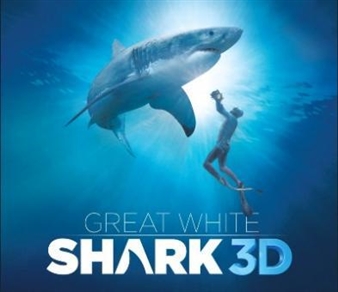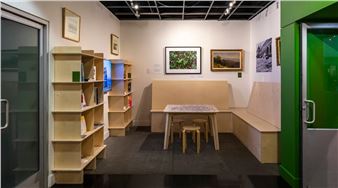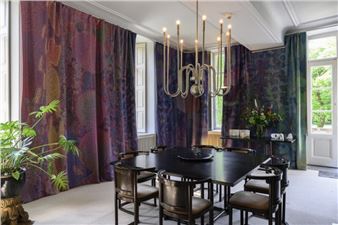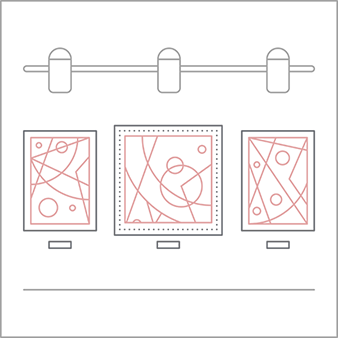Ravel: Associate Artists Group Exhibition
Ravel features the work of Boston Sculptors' 14 Associate Artists. The word "ravel" is a contronym, meaning both "tangle" or "become entangled," as well as to "untangle" or "separate." Many of the featured artists formally or conceptually explore these themes as well as dualities such as strength and vulnerability, clarity and ambiguity, and beauty in imperfection. Showcasing an array of media and techniques, the exhibition offers a snapshot of the region's talented sculptors.
Leslie Schomp, Bruce Armitage, and Delanie Kabrick Wise, explore themes of psychology and universal experiences through their various figurative work. Inspired by the Exquisite Corpse, Schomp's stitched cloth sculptures combine human and animal forms-bodies, skins, and gestures-to communicate various states of human psychology. For Schomp, cloth "acts" like the body. It bundles, stretches, gathers and can be excavated into when it is "unwoven." Armitage's playfully distorted ceramic figures offer narratives, sometimes obvious, other times open to interpretation: A man's reaction to a dog's kiss, a couple's deflecting of blame, a man whose lighthearted gesture could be interpreted in various ways. Stylized elongated features lend a humorous and approachable quality to his figures, but they still read as human, as human as the stories they present. Wise's ceramic sculpture surprises us as she bisects heads and bodies to reveal floral interiors reminiscent of delicate Delftware. For the artist, each is a kind of self- portrait, in the sense that they reflect her own sensibilities and embrace the notion that her own life experiences are not so unique as they are universal.
The work of Jongeun Gina Lee and Joan Mullen addresses the balance of strength and vulnerability through abstraction. Lee's works represent the slow incubation of inner strength and resilience, as well as cautious hope and optimism. Based in ceramics and incorporating metal and fiber, Lee creates sculpture with heavily charged negative space. Using linear elements to articulate the hidden energy in nature which transforms and propels everything on its journey, the pieces serve as a metaphor for the paradoxical adaptability in time and space. Mullen's Gathering II explores the experiential qualities of form through abstraction. The original pieces are built with clay, from which molds are made and cast in a translucent resin. Incorporating light inside each piece, the wall-mounted sculpture evokes people striving to come together, despite arduous challenges, addressing both the strength and vulnerability of the human condition.
Identity, race, and oppression inform the sculpture of Jeffrey Nowlin and Véronica A. Pérez. Nowlin's Shield (Are You Black II) represents the ingrained repercussions of incremental stress stemming from biases, judgements, and questions of belonging. Conjuring a visceral feeling that is difficult to explain, but easily sensed, Nowlin explores what it means to pass through instances of suspicion, categorization, and to exist in the gray of racial identity. An undulating chandelier composed of woven hair, jewels, and beads, Pérez's piece reminds us of what people of color have lost, what they have found, and the paths taken to get here. Its coruscating light is constantly moving and forming, speaking to the silencing of voices through white supremacy and how what was once thought to be lost can be reclaimed.
Themes of memory and relationships to particular places and times are shared in the work of Mark Snyder and Freedom Baird. It is with a palpable sense of care and nostalgia that Snyder recreates from memory an intimate to-scale model of the mobile home in upstate New York where he lived for two years. Constructed of cardboard and 3D printed pieces, the interior is replete with fully furnished rooms which can be viewed through the windows. The artist's pickup truck of the same scale is parked next to the trailer. For Baird, textile quilts create an historical record, memorializing our activities, efforts, and relationships from a specific time and place. Based on a map of the former Pine Manor College campus in Boston, its fabrics donated by the college community, Baird assembled the quilt which was embroidered by students, alumni, and visitors to Pine Manor's last art exhibition shortly before the college was shuttered forever.
Elizabeth Cohen and William Brayton investigate concepts of formal duality in their work. Cohen offers a series of sculptures centered on the form of an egg. Utilizing diverse materials including porcelain, found wood, translucent acrylic, and mulberry paper, the work explores dualities such as exterior and interior, hidden and revealed, clarity and obfuscation, and strength and fragility. As Brayton worked on a new series of stacked wall reliefs in wood, obscured and hidden areas began to appear, which the artist built upon, extrapolating the notion of concealment and the limitations of what can be known. Looking into the depths of each piece, light reveals what is on the surface while shadows and barriers mark the edges of inaccessible spaces.
Lisa Barthelson's Global Consumption installation focuses on the crushing threats to our fragile earth. Using her own family's debris as sculptural material, plastic, cardboard, clothing, and abandoned household items are reconfigured, their chaotic components constrained and organized into planet-like spheres. Barthelson invites viewers to recognize their own consumer waste, their environmental footprint, and to consider the changes needed to ensure a sustainable future for all.
Dayna Talbot and Jo Lobdell consider the distinction between fine art and craft in their textile works. Ritual and repetition guide Talbot's process employing humble materials such as thread, wool, felted fibers, and handmade paper, to construct pieces that blur the line between fine art and craft. Utilizing techniques such as wrapping, tying, and stitching, Talbot's vividly colored explosive forms evoke both familiarity and ambiguity, and the beauty found in imperfection and impermanence. Inspired by a hobby craft her grandmother taught her, Lobdell creates yarn dolls and assembles them into sumptuously soft wall sculpture. Using hand-dyed plant-based yarn, Lobdell embraces organic color shifts and imperfections reflecting the relationship between material abundance and scarcity, as well as themes of time, memory, transformation, and the power of small acts to grow into something larger.
Ravel is the fifth annual exhibition of Boston Sculptors Associate Artists and a wonderful opportunity to experience a diverse array of work by a multi-talented group of sculptors.
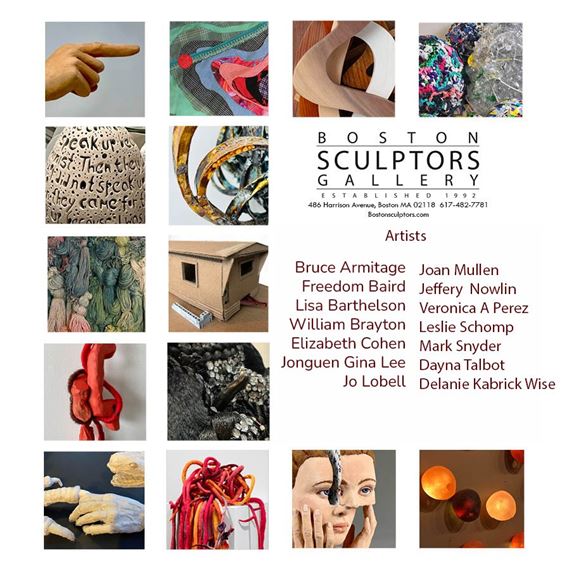
Recommended for you
Ravel features the work of Boston Sculptors' 14 Associate Artists. The word "ravel" is a contronym, meaning both "tangle" or "become entangled," as well as to "untangle" or "separate." Many of the featured artists formally or conceptually explore these themes as well as dualities such as strength and vulnerability, clarity and ambiguity, and beauty in imperfection. Showcasing an array of media and techniques, the exhibition offers a snapshot of the region's talented sculptors.
Leslie Schomp, Bruce Armitage, and Delanie Kabrick Wise, explore themes of psychology and universal experiences through their various figurative work. Inspired by the Exquisite Corpse, Schomp's stitched cloth sculptures combine human and animal forms-bodies, skins, and gestures-to communicate various states of human psychology. For Schomp, cloth "acts" like the body. It bundles, stretches, gathers and can be excavated into when it is "unwoven." Armitage's playfully distorted ceramic figures offer narratives, sometimes obvious, other times open to interpretation: A man's reaction to a dog's kiss, a couple's deflecting of blame, a man whose lighthearted gesture could be interpreted in various ways. Stylized elongated features lend a humorous and approachable quality to his figures, but they still read as human, as human as the stories they present. Wise's ceramic sculpture surprises us as she bisects heads and bodies to reveal floral interiors reminiscent of delicate Delftware. For the artist, each is a kind of self- portrait, in the sense that they reflect her own sensibilities and embrace the notion that her own life experiences are not so unique as they are universal.
The work of Jongeun Gina Lee and Joan Mullen addresses the balance of strength and vulnerability through abstraction. Lee's works represent the slow incubation of inner strength and resilience, as well as cautious hope and optimism. Based in ceramics and incorporating metal and fiber, Lee creates sculpture with heavily charged negative space. Using linear elements to articulate the hidden energy in nature which transforms and propels everything on its journey, the pieces serve as a metaphor for the paradoxical adaptability in time and space. Mullen's Gathering II explores the experiential qualities of form through abstraction. The original pieces are built with clay, from which molds are made and cast in a translucent resin. Incorporating light inside each piece, the wall-mounted sculpture evokes people striving to come together, despite arduous challenges, addressing both the strength and vulnerability of the human condition.
Identity, race, and oppression inform the sculpture of Jeffrey Nowlin and Véronica A. Pérez. Nowlin's Shield (Are You Black II) represents the ingrained repercussions of incremental stress stemming from biases, judgements, and questions of belonging. Conjuring a visceral feeling that is difficult to explain, but easily sensed, Nowlin explores what it means to pass through instances of suspicion, categorization, and to exist in the gray of racial identity. An undulating chandelier composed of woven hair, jewels, and beads, Pérez's piece reminds us of what people of color have lost, what they have found, and the paths taken to get here. Its coruscating light is constantly moving and forming, speaking to the silencing of voices through white supremacy and how what was once thought to be lost can be reclaimed.
Themes of memory and relationships to particular places and times are shared in the work of Mark Snyder and Freedom Baird. It is with a palpable sense of care and nostalgia that Snyder recreates from memory an intimate to-scale model of the mobile home in upstate New York where he lived for two years. Constructed of cardboard and 3D printed pieces, the interior is replete with fully furnished rooms which can be viewed through the windows. The artist's pickup truck of the same scale is parked next to the trailer. For Baird, textile quilts create an historical record, memorializing our activities, efforts, and relationships from a specific time and place. Based on a map of the former Pine Manor College campus in Boston, its fabrics donated by the college community, Baird assembled the quilt which was embroidered by students, alumni, and visitors to Pine Manor's last art exhibition shortly before the college was shuttered forever.
Elizabeth Cohen and William Brayton investigate concepts of formal duality in their work. Cohen offers a series of sculptures centered on the form of an egg. Utilizing diverse materials including porcelain, found wood, translucent acrylic, and mulberry paper, the work explores dualities such as exterior and interior, hidden and revealed, clarity and obfuscation, and strength and fragility. As Brayton worked on a new series of stacked wall reliefs in wood, obscured and hidden areas began to appear, which the artist built upon, extrapolating the notion of concealment and the limitations of what can be known. Looking into the depths of each piece, light reveals what is on the surface while shadows and barriers mark the edges of inaccessible spaces.
Lisa Barthelson's Global Consumption installation focuses on the crushing threats to our fragile earth. Using her own family's debris as sculptural material, plastic, cardboard, clothing, and abandoned household items are reconfigured, their chaotic components constrained and organized into planet-like spheres. Barthelson invites viewers to recognize their own consumer waste, their environmental footprint, and to consider the changes needed to ensure a sustainable future for all.
Dayna Talbot and Jo Lobdell consider the distinction between fine art and craft in their textile works. Ritual and repetition guide Talbot's process employing humble materials such as thread, wool, felted fibers, and handmade paper, to construct pieces that blur the line between fine art and craft. Utilizing techniques such as wrapping, tying, and stitching, Talbot's vividly colored explosive forms evoke both familiarity and ambiguity, and the beauty found in imperfection and impermanence. Inspired by a hobby craft her grandmother taught her, Lobdell creates yarn dolls and assembles them into sumptuously soft wall sculpture. Using hand-dyed plant-based yarn, Lobdell embraces organic color shifts and imperfections reflecting the relationship between material abundance and scarcity, as well as themes of time, memory, transformation, and the power of small acts to grow into something larger.
Ravel is the fifth annual exhibition of Boston Sculptors Associate Artists and a wonderful opportunity to experience a diverse array of work by a multi-talented group of sculptors.

 ARTISTS
ARTISTS









